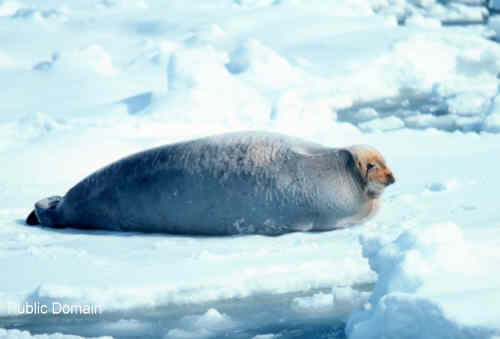Bearded Seal (Erignathus barbatus)

Appearance
The bearded seal is a large Arctic seal with a robust body, small head, and a squareish snout framed by long, stiff vibrissae. Adults typically reach 2.1–2.7 m and 200–430 kg. The coat ranges from gray to brown with faint mottling; pups (called “bluebacks”) are dark slate with pale sides.
Distribution
Found circumpolarly in Arctic and sub-Arctic waters: Beaufort, Chukchi, Bering, and Okhotsk seas; Barents and Kara seas; around Greenland, Svalbard, and the Canadian Arctic. They favor shallow shelves and nearshore zones.
Habitat
Strongly associated with seasonal sea ice, ice edges, and drifting floes over shallow, soft-sediment bottoms where benthic prey is abundant. In summer, individuals may use coastal haul-outs and estuaries.
Behavior
Generally solitary or in small, loosely spaced groups on ice floes. They are capable divers, typically to 100–300 m. Their long whiskers help detect prey vibrations on the seafloor. Vocalizations (trills and moans) carry over long distances during the breeding season.
Diet
Primarily benthic invertebrates and demersal fishes: clams, snails, crabs, shrimp, and sculpins/cod. Foraging is mostly at the bottom; whiskers aid tactile hunting in turbid water.
Reproduction
Breeding occurs in late winter to spring. After ~11–12 months (including delayed implantation), a single pup is born on pack ice in spring. Pups are weaned in a few weeks and quickly become capable swimmers.
Threats
Major pressures include loss and timing shifts of sea ice from climate change, increased Arctic shipping and noise, and potential bycatch. Indigenous subsistence harvests are managed regionally. Conservation status varies by region but is often listed as Least Concern with data-deficient subpopulations.
Bearded Seal Facts – Whiskered Benthic Specialist
The species’ dense, sensitive whiskers function like tactile antennas, helping locate buried prey in soft sediments.
Population and Conservation
Several hundred thousand are estimated range-wide, split among regional stocks. Long-term monitoring focuses on ice dependence and human activity expansion in the Arctic.
Interesting Facts
- Pups are nicknamed “bluebacks” for their dark juvenile coats.
- Distinct musical trills echo under sea ice during breeding season.
- Square snout and powerful foreflippers help probe sediments for clams and worms.
FAQs about Bearded Seals
Why the long whiskers?
They detect vibrations and shapes of prey on the seafloor.
Do bearded seals migrate?
They show seasonal movements with ice dynamics, often staying within shelf regions.
